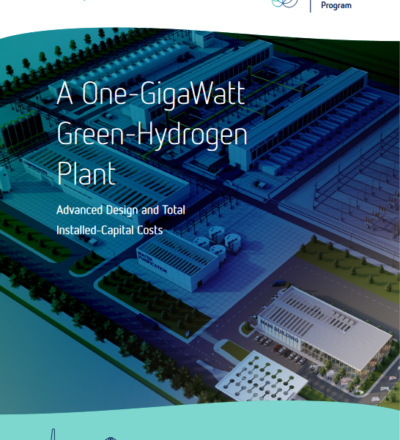Green hydrogen can replace natural gas as an energy carrier and industry feedstock to reduce CO2 emissions. This transition requires economies of scale with the production of large volumes of green hydrogen in many large-scale water-electrolysis plants. These plants will be powered by large wind and solar parks that will have to be built within the next ten years. The goals here are really ambitious. The European Union (EU) aims to have 40-GW of electrolyzer capacity installed by 2030, while the ambition in the Netherlands is to have built green-hydrogen plants with a combined capacity of 3 to 4 GW by that date. The largest existing electrolyzers are at the 10-MW scale, whereas scaling up to GW scale is needed at acceptable cost levels.
The Hydrohub GigaWatt-Scale Electrolyzer project has produced an advanced design for such a 1 GW green hydrogen plant, which would use alkaline water electrolysis (AWE) and polymer electrolyte membrane (PEM) water electrolysis, and which could start up in 2030. This advanced design builds on a previous state-of-the-art 2020 baseline design,1 and foresees a considerable drop in investment costs (CAPEX). Consequently, the levelized cost of hydrogen (LCOH) is expected to come down in the lead-up to 2030, and to continue its decline thereafter. Still, more needs to be done to create a competitive green-hydrogen market.
We present the technical design and the associated total investment costs of a greenfield 1-GW green-hydrogen plant that would be built, and up and running, in a Dutch port area by 2030. This project shows that anticipated total investment cost levels of 730 €/kW or 1580 €/(kg/d) for AWE and 830 €/kW or 1770 €/(kg/d) for PEM are within reach. The CAPEX required will be about half of
what would be required for the 2020 state-of-the-art design. To come to this cost reduction, sever improvements have been made to the state-of-the-art 2020 design – see Figure 3. We incorporated innovations at the stack level, scaling up to larger stacks and modules, and came up with optimizations for, and other improvements to, the electrical installations, utilities, and balance of plants.
🎧 Prefer listening? Dive into the essentials of this publication with our 16-minute podcast, generated by Google’s NotebookLM.
Download your free copy
Our publications are free to access. Simply provide your first name and email address to download.
